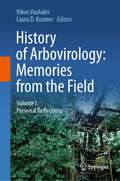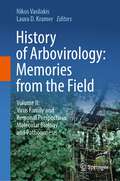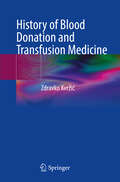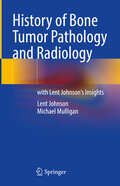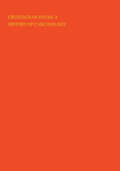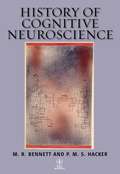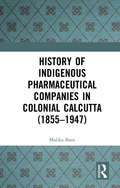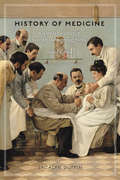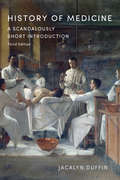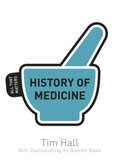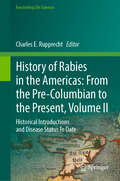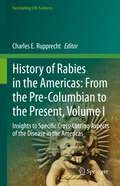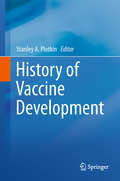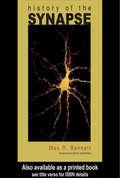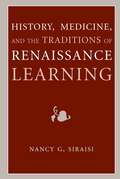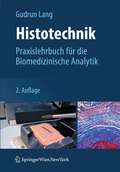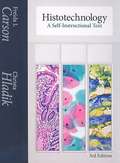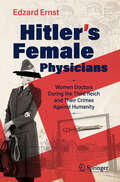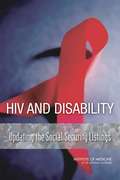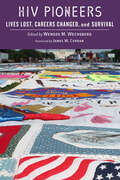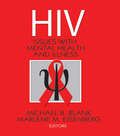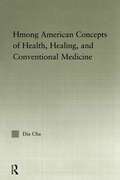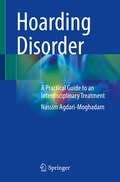- Table View
- List View
History of Arbovirology: Volume I: Personal Reflections
by Laura D. Kramer Nikos VasilakisThese books bring together a panel of expert arbovirologists who recall the history of arbovirology from very personal perspectives. In these timely volumes, the authors describe seminal moments in their experiences in the field and how they integrated these findings with lab studies to further clarify the ecology and epidemiology of diverse arboviruses. Authors identify the most pressing questions that remain to be answered, providing a basis for current research and a stimulus to engage those entering the field. Over the last 20 years a generational gap has developed between the giants of arbovirus research and discovery and the new generation. This gap developed due to an ebbing of training and investment in passing the scepter to the next generation, leading to a lack of continuity among the generations that threatens to derail the rich history of virus discovery, field epidemiology and understanding of the richness of diversity that surrounds us. This lack of continuity may have immediate and disastrous consequences for public health when yet to be discovered arboviruses emerge. The purpose of these books is to bridge this gap by providing a historical context for the work being done today and provide continuity between the generations. To this end, the books provide a narrative of the thrill of scientific discovery and excitement of field adventures and lab studies of that generation -- essential reading for every arbovirologist, and highly recommended for all virologists and public health officials, as well as those students considering future research options. Volume I consists of the personal reflections of arbovirologists who played a significant role in the advancement of arbovirology across the globe. Volume II transitions to descriptions of region-specific and virus family-specific perspectives of arbovirology, as well as recollections of the early events of molecular advances and pathogenesis studies.Volume I presents personal reflections from arbovirologists key to the understanding and advancement of this fieldOffers a comprehensive historical analysis of arbovirology by crucial contributors to this fieldFirst-hand narratives of seminal studies and experiments, illuminating how these have contributed to current knowledge
History of Arbovirology: Volume II: Virus Family and Regional Perspectives, Molecular Biology and Pathogenesis
by Laura D. Kramer Nikos VasilakisThese books bring together a panel of expert arbovirologists who recall the history of arbovirology from very personal perspectives. In these timely volumes, the authors describe seminal moments in their experiences in the field and how they integrated these findings with lab studies to further clarify the ecology and epidemiology of diverse arboviruses. Authors identify the most pressing questions that remain to be answered, providing a basis for current research and a stimulus to engage those entering the field. Over the last 20 years a generational gap has developed between the giants of arbovirus research and discovery and the new generation. This gap developed due to an ebbing of training and investment in passing the scepter to the next generation, leading to a lack of continuity among the generations that threatens to derail the rich history of virus discovery, field epidemiology and understanding of the richness of diversity that surrounds us. This lack of continuity may have immediate and disastrous consequences for public health when yet to be discovered arboviruses emerge. The purpose of these books is to bridge this gap by providing a historical context for the work being done today and provide continuity between the generations. To this end, the books provide a narrative of the thrill of scientific discovery and excitement of field adventures and lab studies of that generation -- essential reading for every arbovirologist, and highly recommended for all virologists and public health officials, as well as those students considering future research options. Volume I consists of the personal reflections of arbovirologists who played a significant role in the advancement of arbovirology across the globe. Volume II transitions to descriptions of region-specific and virus family-specific perspectives of arbovirology, as well as recollections of the early events of molecular advances and pathogenesis studies.Volume II addresses region- and virus family-specific perspectives, as well as molecular biology and pathogenesisOffers a comprehensive historical analysis of arbovirology by crucial contributors to this fieldFirst-hand narratives of seminal studies and experiments, illuminating how these have contributed to current knowledge
History of Blood Donation and Transfusion Medicine
by Zdravko KvržićThis book offers a global overview of the history of blood donation using evidence-based research to provide accurate information on the beginnings of blood donation and transfusion medicine, developed as the result of numerous trials and successes throughout history. It leads the reader step-by-step through time, to discover how people perceived blood, and how they managed to develop new ways of treating various unfortunate conditions that shattered a person’s healthy life. This book also presents new technical discoveries that have advanced through the present day and explains how, in cases of deadly diseases, safety procedures for blood examination have been made mandatory. The conditions that led to the contamination of thousands of patients by HIV and hepatitis C around the world are explained, and the debate between voluntary and paid systems is covered as well. This book is a unique resource beneficial for everyday practice, as it encourages the reader to develop advanced practices for better and safer work with blood donors and in transfusion medicine; It gives a sense of humanitarian devotion to the deed of giving a part of yourself to save others’ lives in danger because of trauma, disease, etc., and it shares different stories of blood donors, to help patients get over their fear of donating blood. It is useful for nurses, doctors, students, blood donors, historians, and other experts!
History of Bone Tumor Pathology and Radiology: with Lent Johnson's Insights
by Michael Mulligan Lent JohnsonThis book expands on the work of Dr. Lent Johnson, a major figure in the history of bone tumor pathology and bone tumor radiology, and updates it to provide a comprehensive history of those fields. Dr. Johnson began work on this book in the early 1990s, at the end of his 52-year career at the Armed Forces Institute of Pathology (AFIP) in Washington, DC. Dr. Michael Mulligan worked with him there during his Army service as a Radiologist at the Walter Reed Army Medical Center. Dr. Johnson asked Dr. Mulligan to review his initial draft chapters, but Dr. Johnson died in 1998 and the work was never completed. Dr. Mulligan’s intention was to complete it in tribute. The book is structured with Dr. Johnson’s initial chapters describing the early history of the development of the specialties of bone pathology and skeletal radiology with an emphasis on the research and teaching programs established at the AFIP. Dr. Mulligan then provides additional information on subsequent developments from the last 30+ years to provide a complete picture of the current state of the field. This is an ideal guide for pathologists, radiologists, and all other medical professionals interested in the history of these specialties.
History of Carcinology (Advances In Crustacean Research Ser. #Vol. 8)
by Frank TruesdaleThe papers in this volume take several forms, from strict chronologies to detailed historical analyses. Topics covered include: towards the history of pre-Linnean carcinology in Brazil; the beginning of Portugese carcinology; from Oviedo to Rathbun; the development of brachturan crab tascononry in the Neotropics (1535-1937); studies on decapod crustaceans of the Pacific Coast of the United States and Canada; women's contributions to carcinology; reflections on crab research in North America since 1758; carcinology in classical Japanese work.
History of Cognitive Neuroscience
by P. M. Hacker M. R. BennettHistory of Cognitive Neuroscience documents the major neuroscientific experiments and theories over the last century and a half in the domain of cognitive neuroscience, and evaluates the cogency of the conclusions that have been drawn from them. Provides a companion work to the highly acclaimed Philosophical Foundations of Neuroscience - combining scientific detail with philosophical insights Views the evolution of brain science through the lens of its principal figures and experiments Addresses philosophical criticism of Bennett and Hacker's previous book Accompanied by more than 100 illustrations
History of Indigenous Pharmaceutical Companies in Colonial Calcutta (1855–1947)
by Malika BasuIn the context of life and civilization, the pharmaceutical industry is as old as human existence. Since time immemorial India had its own enriched indigenous tradition of medicine. The development of alchemy and its application for human welfare was also an important step in Indian scientific tradition. The present monograph is an innovative attempt to understand the history of the indigenous pharmaceutical companies in Calcutta during the colonial times. Here pharmaceutical companies have been viewed as an illuminating lens to understand the interconnectedness between Indian traditions of thought and Western science and subsequent development of pharmaceutical industry in colonial India. The entire gamut of discussion centres around the issues of medical education, medical services, public health, pharmaceutical profession and politico-economic contexts of the development of pharmaceutical industry in colonial India. Three indigenous pharmaceuticals namely – Butto Krishna Paul & Co., Bengal Chemical & Pharmaceutical Works Limited, and East India Pharmaceutical Works Limited have been studied. The study not only portrays the politico-economic background to the emergence of the pharmaceutical industry in colonial India but links it to the economic nationalism and the quest for self-sufficiency among Indian nationalists and entrepreneurs. The pharmaceutical industry in India can be symbolic of a cultural response to modern science which was to pave the subsequent trajectory of national scientific endeavours in India.Please note: Taylor & Francis does not sell or distribute the Hardback in India, Pakistan, Nepal, Bhutan, Bangladesh and Sri Lanka.
History of Medicine, Second Edition: A Scandalously Short Introduction
by Jacalyn DuffinJacalyn Duffin's History of Medicine has for ten years been one of the leading texts used to teach medical and nursing students the history of their profession. It has also been widely used in history courses and by general readers. An accessible overview of medical history, this new edition is greatly expanded, including more information on medicine in the United States, Great Britain, and in other European countries. The book continues to be organized conceptually around the major fields of medical endeavor such as anatomy, pharmacology, obstetrics, and psychiatry and has grown to include a new chapter on public health.Years of pedagogic experience, medical developments, and reader feedback have led to new sections throughout the book on topics including bioethics, forensics, genetics, reproductive technology, clinical trials, and recent outbreaks of BSE, West Nile Virus, SARS, and anthrax. Up to date and filled with pithy examples and teaching tools such as a searchable online bibliography, History of Medicine continues to demonstrate the power of historical research to inform current health care practice and enhance cultural understanding.
History of Medicine: A Scandalously Short Introduction, Third Edition
by Jacalyn DuffinJacalyn Duffin's History of Medicine is one of the leading texts used to teach the history of the medical profession. Emphasizing broad concepts rather than names and dates, it has also been widely appreciated by general readers for more than twenty years. Based on sound scholarship and meticulous research, History of Medicine incorporates pithy examples from a range of periods and places and is infused with the author’s characteristic wit. The third edition has been completely revised to highlight new scholarship on the past and incorporate significant medical events of the most recent decade – including new technologies, drug shortages, medical assistance in dying, and recent outbreaks of infectious diseases such as Ebola, H1N1, Zika, and COVID-19. The book is organized around themes of scientific and clinical interest, such as anatomy, physiology, pharmacology, surgery, obstetrics, medical education, health-care delivery, and public health. It includes a chapter on how to approach research in medical history, updated with new resources. History of Medicine is sensitive to the power of historical research to inform current health-care practice and enhance cultural understanding.
History of Medicine: All That Matters
by Tim HallThe History of Medicine is an amiable amble through medicine's past, designed as a primer for those taking history of medicine modules as part of their studies and for the wider public seeking a relaxed yet informative read. The approach is to follow medicine's history through the author's neatly designed 'Ages' that offer a meaningful way of grasping and memorising key eras and events. Twenty one 'Ages' take us from 'pre-history' to a glimpse of the future. The chapters' themes will clearly straddle timelines rather than be perfectly chronological, although there is a general progression through time. This book is not a description of all that ever happened in medicine's history. It is a collection of true stories of the more pivotal and fascinating bits. Through stories of inspiring and often odd people and inspired and often distinctly unexpected objects we take a journey through the archipelago of medicine's somewhat quirky history and stop on the shores of some of its more alluring islands. Then, armed with the map, the more keenly disposed may dip into the surrounding waters as far and as deeply as they choose.
History of Medicine: All That Matters (All That Matters)
by Tim HallThe History of Medicine is an amiable amble through medicine's past, designed as a primer for those taking history of medicine modules as part of their studies and for the wider public seeking a relaxed yet informative read. The approach is to follow medicine's history through the author's neatly designed 'Ages' that offer a meaningful way of grasping and memorising key eras and events. Twenty one 'Ages' take us from 'pre-history' to a glimpse of the future. The chapters' themes will clearly straddle timelines rather than be perfectly chronological, although there is a general progression through time. This book is not a description of all that ever happened in medicine's history. It is a collection of true stories of the more pivotal and fascinating bits. Through stories of inspiring and often odd people and inspired and often distinctly unexpected objects we take a journey through the archipelago of medicine's somewhat quirky history and stop on the shores of some of its more alluring islands. Then, armed with the map, the more keenly disposed may dip into the surrounding waters as far and as deeply as they choose.
History of Rabies in the Americas: Historical Introductions and Disease Status To Date (Fascinating Life Sciences)
by Charles E. RupprechtRabies is one of the oldest known pathogens, is incurable, and has the highest fatality rate of all infectious diseases. The Americas is the only region with bat rabies virus, including vampire bat rabies. The region is rich in cultural references and notable for many discoveries in the field, including the current vaccine potency test, diagnostic assay, conception of oral vaccines for wildlife, the first human survivor and the first successful canine rabies program executed at a broad level. Rabies remains the most important viral zoonosis, with tens of thousands of human fatalities and tens of millions of exposures annually, which can be used to model for other pathogens, such as COVID-19. There is an international effort to eliminate human rabies caused by dogs over the next decade, and the Americas represent the primary region with the greatest proof-of-concept evidence to accomplish this goal. This two-volume set addresses the medical history and modern results of rabies in countries throughout the Americas, including the implications of and on cultural, economic, sociological, and research developments in the region. Volume II provides an in-depth analysis of the rabies' presence and impact in specific countries, including historical perspectives, advances in research and understanding, and current status.
History of Rabies in the Americas: Insights to Specific Cross-Cutting Aspects of the Disease in the Americas (Fascinating Life Sciences)
by Charles E. RupprechtRabies is one of the oldest known pathogens, is incurable, and has the highest fatality rate of all infectious diseases. The Americas is the only region with bat rabies virus, including vampire bat rabies. The region is rich in cultural references and notable for many discoveries in the field, including the current vaccine potency test, diagnostic assay, conception of oral vaccines for wildlife, the first human survivor and the first successful canine rabies program executed at a broad level. Rabies remains the most important viral zoonosis, with tens of thousands of human fatalities and tens of millions of exposures annually, which can be used to model for other pathogens, such as COVID-19. There is an international effort to eliminate human rabies caused by dogs over the next decade, and the Americas represent the primary region with the greatest proof-of-concept evidence to accomplish this goal. This two-volume set addresses the medical history and modern results of rabies in countries throughout the Americas, including the implications of and on cultural, economic, sociological, and research developments in the region. Volume I presents an overview of concepts critical to the study of rabies in the region, including evolutionary aspects, reservoir ecology and control, elimination efforts, vaccine development, and disease hallmarks and progression. It also analyzes the long-term cultural, social, and economic impacts of the disease in the Americas.
History of Vaccine Development
by Stanley A. PlotkinVaccinology, the concept of a science ranging from the study of immunology to the development and distribution of vaccines, was a word invented by Jonas Salk. This book covers the history of the methodological progress in vaccine development and to the social and ethical issues raised by vaccination. Chapters include "Jenner and the Vaccination against Smallpox," "Viral Vaccines," and "Ethical and Social Aspects of vaccines." Contributing authors include pioneers in the field, such as Samuel L. Katz and Hilary Koprowski. This history of vaccines is relatively short and many of its protagonists are still alive. This book was written by some of the chief actors in the drama whose subject matter is the conquest of epidemic disease.
History of the Synapse
by Max R. BennettThe History of the Synapse provides a history of those discoveries concerning the identification and function of synapses that provide the foundations for research during this new century with a personal view of the process by which new concepts have developed. Previously published as essays, the chapters in this book provide a history of various a
History, Medicine, and the Traditions of Renaissance Learning
by Nancy G. SiraisiA major, path-breaking work, History, Medicine, and the Traditions of Renaissance Learning is Nancy G. Siraisi's examination into the intersections of medically trained authors and history in the period 1450 to 1650. Rather than studying medicine and history as separate disciplinary traditions, Siraisi calls attention to their mutual interaction in the rapidly changing world of Renaissance erudition. Far from their contributions being a mere footnote in the historical record, medical writers had extensive involvement in the reading, production, and shaping of historical knowledge during this important period. With remarkably detailed scholarship, Siraisi investigates doctors' efforts to explore the legacies handed down to them from ancient medical and anatomical writings and the difficult reconciliations this required between the authority of the ancient world and the discoveries of the modern. She also studies the ways in which sixteenth-century medical authors wrote history, both in their own medical texts and in more general historical works. In the course of her study, Siraisi finds that what allowed medical writers to become so fully engaged in the writing of history was their general humanistic background, their experience of history through the field of medicine's past, and the tools that the writing of history offered to the development of a rapidly evolving profession.
Histotechnik
by Gudrun LangIn dem Band stellt die Autorin Theorie und Praxis der unterschiedlichen histologischen Techniken umfassend dar. Sie erklärt nicht nur das Vorgehen, das "Wie", sondern auch das "Warum" und vermittelt so ein fundiertes Verständnis der Verfahren und ihrer Anwendung. Der Band enthält außerdem Kapitel zur Qualitätssicherung und zur Sicherheit im Labor, einen historischen Überblick sowie eine Übersicht über gebräuchliche Chemikalien und ihre Eigenschaften. Die Neuauflage berücksichtigt aktuelle Verfahren, darunter neueste molekularbiologische Techniken.
Histotechnology: A Self-instructional Text
by Freida L. Carson Christa HladikAn indispensable teaching tool and reference--and a "must" for histotechnologists preparing for the ASCP HTL certifying examination--Histotechnology has been completely updated in the new 3rd edition. New coverage includes chapters on immunohistochemistry and molecular techniques and cytopreparation. You'll also appreciate new features incorporated throughout the book--new images, how-to illustrations for manual techniques, troubleshooting aids, and additional special staining procedures.
Hitler’s Female Physicians: Women Doctors During the Third Reich and Their Crimes Against Humanity
by Edzard ErnstThere have been many books about the doctors of the Third Reich and their atrocities. Most of these books neglect the contribution of women in the medical profession. In this book, they are the focus of attention. The first section of the book explains the background of the Third Reich in general and medicine during this period in particular. It addresses the situation of female doctors and why there were relatively few of them. It goes on to detail the forms of transgression that occurred under Nazi rule—involuntary sterilization, euthanasia, and mass murder of Jews and other groups considered undesirable. The second part of the book is a collection of 38 alphabetically arranged biographies of individual female doctors who participated in these activities. It reports on the actions they took and what happened to them after the war. The final chapter draws some conclusions, which can be briefly summarized as follows: 1) the female doctors' role remains under-researched, 2) generally speaking, female doctors were also guilty, but their transgressions generally less gruesome than those of their male colleagues, 3) many of the deeds of female doctors are nevertheless shocking.
Hitting America's Soft Underbelly: The Potential Threat of Deliberate Biological Attacks Against the U. S. Agricultural and Food Industry
by Peter ChalkOver the past decade, the United States has endeavored to increase its ability to detect, prevent, and respond to terrorist threats and incidents. The agriculture sector and the food industry in general, however, have received comparatively little attention with respect to protection against terrorist incidents. This study aims to expand the current debate on domestic homeland security by assessing the vulnerabilities of the agricultural sector and the food chain to a deliberate act of biological terrorism and exploring the likely outcomes of a successful attack.
Hiv And Disability: Updating the Social Security Listings
by Institute of Medicine of the National AcademiesThe Social Security Administration (SSA) uses a screening tool called the Listing of Impairments to identify claimants who are so severely impaired that they cannot work at all and thus qualify for disability benefits. In this report, the IOM makes several recommendations for improving SSA's capacity for determining disability benefits more accurately and quickly using the HIV Infection Listings.
Hiv Pioneers: Lives Lost, Careers Changed, and Survival
by Wendee M. WechsbergA moving collection of firsthand accounts of the beginning of the HIV epidemic in the 1980s.Tremendous strides have been made in the prevention and treatment of HIV since the disease first appeared in the 1980s. But because many of those who studied and battled the virus in its early days are now gone, firsthand accounts are at risk of being lost. In HIV Pioneers, Wendee M. Wechsberg collects 29 “first stories” from the outset of the AIDS epidemic. These personal narratives and historical essays not only shed light on the experiences of global health pioneers, prominent scientists, and HIV survivors, but also preserve valuable lessons for managing the risk and impact of future epidemics.With unprecedented access to many key actors in the fight against AIDS and HIV, Wechsberg brings to life the harrowing reality in the beginning of the epidemic. The book captures the experiences of those still working diligently and innovatively in the field, elevating the voices of doctors, scientists, and government bureaucrats alongside those of survivors and their loved ones. Focusing on the impact that the epidemic had on careers, pieces also show how governments responded to HIV, how research agendas were developed, and how AIDS service agencies and case management evolved.Illuminating the multiple facets of the HIV epidemic, both in the United States and across the globe, HIV Pioneers is a touching and inspirational look into the ongoing fight against HIV.“Anyone interested in science, social history, communicable diseases or epidemiology would benefit from reading this topical, fascinating and inspirational book.” —Fay Hartley, British Society for the History of Medicine
Hiv: Issues with Mental Health and Illness
by Michael B. Blank Marlene M. EisenbergLearn why it&’s time for a new era in mental health and prevention scienceHIV: Issues with Mental Health and Illness is a comprehensive examination of the co-morbidity that exists between HIV/AIDS and mental illness. Internationally recognized experts in the field analyze the latest research on why HIV sufferers are at risk of developing mental illness and how people who suffer from mental illness risk contracting HIV through sexual behavior and substance abuse. This unique book focuses on clinical and diagnostic issues, the organization of service delivery systems, and community-based interventions.HIV: Issues with Mental Health and Illness presents vital contributions from physicians, sociologists, nurses, social workers, and psychologists working to develop a plan to reduce the number of persons affected by the epidemic, and to improve the quality of life of those already HIV infected. Aimed at promoting a new era in mental health and prevention science, the book examines vital issues including: the interplay between depression, HIV, and chronic fatigue; condom use among adolescents with psychiatric disorders; predicting HIV risk and how targeted intervention can address multiple health risks; how an increase in emotional stress can affect African-American women concerned about becoming HIV infected; STI risk reduction strategies; how client gender can affect mental health care service delivery; and the implementation of intervention programs as part of supported housing programs.HIV: Issues with Mental Health and Illness examines: bridging the gap between research and practice depression and HIV schizophrenia and HIV mental health policy and infectious diseases HIV prevention community-based participatory research community psychology mental health disparities translation research transforming public health systemsHIV: Issues with Mental Health and Illness is an invaluable resource for public health workers and policymakers, psychologists, psychiatrists, social work nurses, infectious disease physicians, and addictions disease counselors.
Hmong American Concepts of Health (Studies in Asian Americans)
by Dia ChaAmerica's healthcare system in the twenty-first century faces a variety of pressures and challenges, not the least of which is that posed by the increasingly multicultural nature of American society itself. Large numbers among the Hmong, immigrants from the landlocked Asian nation of Laos, continue to prefer their own ancient medical traditions. That these Hmong Americans should continue to adhere to a tradition of folk medicine, rather than embrace the modern healthcare system of America, poses questions that must be answered. This book takes up the task of examining Hmong American concepts of health, illness and healing, and looks at the Hmong American experience with conventional medicine. In so doing, it identifies factors that either obstruct or enable healthcare delivery to the Hmong, specifically a target sample of Hmong Americans resident in Colorado. Drawing upon scientific methods of data collection, the research reveals attitudes currently held by a group of American citizens toward health and medicine which run the gamut from the very modern to those which have prevailed in the highlands of Southeast Asia for centuries.
Hoarding Disorder: A Practical Guide to an Interdisciplinary Treatment
by Nassim Agdari-MoghadamThis book offers in-depth information on pathological hoarding, describing both the root of the disorder and its progression. How can hoarding disorder be diagnosed? What are the challenges involved in treatment? How can professionals best deal with those affected? In this practical guide, health professionals will find the answers to these and many other questions.In the last few years the awareness of this disorder has gradually increased – not only in the academic community, but also in the media – and it has become clear that there are a considerable number of people worldwide who continue to suffer from it. The case studies presented here share essential insights into the diverse backgrounds and lives of affected individuals. In addition, hoarding disorder has since been classified as a new mental disorder by the WHO, which means many psychoanalysts, psychologists, psychiatrists and social workers will need to be trained accordingly. This book offers valuable guidance.
